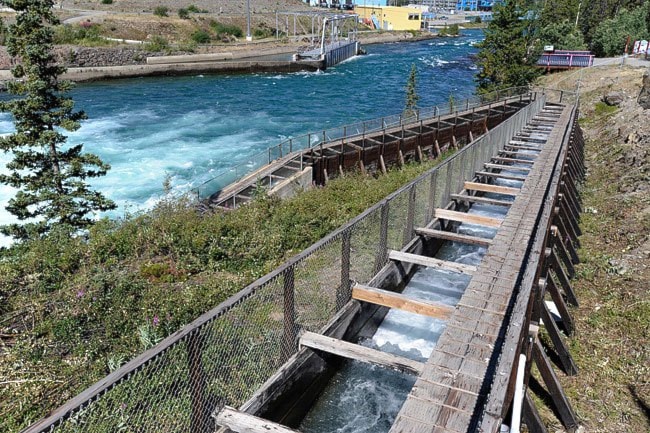Alaskan officials say that they will not meet their obligation to let more than 42,500 chinook salmon cross the border this year.
Canadians and Americans work co-operatively under the Yukon River Salmon Agreement to ensure that enough fish make it to their spawning streams to ensure the future health of the resource.
However, declining returns have officials and fishermen worried on both sides of the border.
Pre-season projections for this year’s run suggested that between 109,000 and 146,000 chinook salmon would enter the Yukon River, a “below average to poor” run, according to a Yukon River Panel report.
Those numbers had been adjusted down because, since 2007, the projection model had been overestimating the run size.
Despite this adjustment, the run was even poorer than expected, with 106,731 chinook passing the Pilot Station Sonar counter near the mouth of the Yukon River.
Genetic surveys at a test fishery indicated that 45 per cent of those fish were headed for Canadian streams to spawn.
As of yesterday, 31,067 chinook had made it to the Eagle Sonar counter just above the border, and by the end of the season that number is expected to reach between 32,000 and 36,000.
The spawning escapement goal, meaning the number of Canadian chinook that escape harvest on either side of the border, was set at 42,500 to 55,000 for 2012.
Under the treaty, the Americans must allow not only the number of fish required for spawning to cross the border, but also a share of the harvest for Canadian fisheries.
But although the number of fish expected to cross the border falls well short of escapement goals, fishing continues on both sides of the border.
There are no penalties specified in the treaty for failing to meet the targets.
On the Alaskan side, officials managed the fishery by limiting the time that subsistence fishermen were allowed on the water.
Restrictions were placed on fishermen targeting chum salmon in order to reduce the bycatch of chinook. The incidental catch of chinook within the river is estimated to be 2,388 fish this year to date.
The Alaskan governor has asked the U.S. Secretary of Commerce to declare the 2012 chinook run a disaster.
In Canada, this year’s run puts us in the “yellow zone” of management decisions, meaning that only First Nation harvesting will be permitted.
The “yellow zone” applies to runs where between 30,000 and 51,000 chinook make it past the border.
Because this year’s run is at the low end of the yellow zone, the Department of Fisheries and Oceans is working with First Nations to limit the harvest.
Several First Nations have announced they are asking fishermen to reduce or stop fishing, and it is up to each of them individually to determine restrictions and enforcement.
If the run dropped below 30,000, DFO could consider shutting down the fishery altogether. That action has never been taken.
As of Thursday, two chinook salmon had made their way up the Whitehorse Fishway, and there were several more pooling near the entrance of the ladder. It’s too soon to tell how many fish will make it past that hurdle, although usually many more fish have made it by this time.
While the chinook run flounders, the return of fall chum is strong this year. Around 1.3 million fall chum are expected to enter the Yukon River, compared to an average of 790,000.
While chinook are praised for their high fat content and good taste, chum are sometimes referred to as dog salmon because they are used primarily as animal food.
Around 30 per cent of the Yukon River fall chum are estimated to be of Canadian origin, however they do not migrate as far as the chinook, and benefit only communities close to the border on the Yukon River, as well as Old Crow on the Porcupine River.
Contact Jacqueline Ronson at
jronson@yukon-news.com
